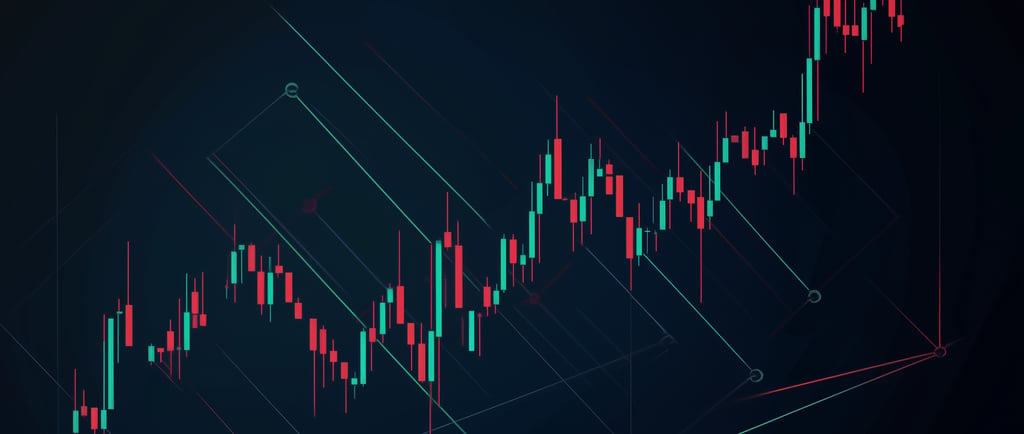

Disclosure: Clicking on links may earn me commission at no additional cost to you. Thank you for reading!
Learn to read and understand candlestick charts with clear examples and insights.
Understanding Candlesticks: Complete Guide & Examples
Disclaimer: This website and its content are for informational purposes only and is not financial advice.
The Basics of Candlestick Anatomy
At its core, a candlestick represents price action over a specific period, whether it's one minute, one hour, one day, or even a month. Each candlestick typically consists of a "body" and "wicks" (sometimes called "shadows").
The body shows the opening and closing prices, while the wicks indicate the highest and lowest prices reached during that period. The color of the body is crucial for understanding candlesticks quickly: a green (or white) body usually signifies that the closing price was higher than the opening price, indicating a bullish period.
Conversely, a red (or black) body suggests the closing price was lower than the opening price, pointing to a bearish period. This visual simplicity is a key reason why understanding candlesticks has become so popular in technical analysis.
Decoding Bodies and Wicks
Let's delve deeper into the components and what they convey. The top of a green candlestick's body is the closing price, and the bottom is the opening price. For a red candlestick, the top of the body is the opening price, and the bottom is the closing price.
The length of the body itself provides insights. A long body, whether green or red, indicates strong buying or selling pressure during that period. A short body, on the other hand, suggests less significant price movement and perhaps indecision in the market.
When you're in the process of understanding candlesticks, paying attention to body length is essential for grasping the immediate market mood.
The wicks, or shadows, extend from the top and bottom of the body. The upper wick shows the highest price reached during the period, while the lower wick shows the lowest price. Long wicks can signify a battle between buyers and sellers.
For example, a long upper wick on a green candlestick might indicate that buyers pushed the price high, but sellers stepped in and pushed it back down before the close.
Similarly, a long lower wick on a red candlestick could mean sellers drove the price down, but buyers emerged to push it back up. These wicks provide crucial context when understanding candlesticks, revealing price volatility and potential turning points.
Key Candlestick Patterns
Doji
One of the most frequently observed patterns when understanding candlesticks is the "Doji." A Doji occurs when the opening and closing prices are virtually the same, resulting in a very small or almost non-existent body. This pattern suggests indecision in the market, with neither buyers nor sellers gaining significant control.
Dojis often appear at market turning points, hinting that a trend might be losing momentum or or is about to reverse. Recognizing a Doji is a key step in understanding candlesticks beyond just single price movements.
Hammer and Hanging Man
Another important pattern for understanding candlesticks is the "Hammer" and its bearish counterpart, the "Hanging Man." A Hammer is a bullish reversal pattern that typically appears after a downtrend. It has a small body at the top of the trading range and a long lower wick, which should be at least twice the length of the body.
This indicates that sellers pushed the price down, but buyers powerfully stepped in to push it back up, suggesting a potential bullish reversal. Conversely, the Hanging Man is a bearish reversal pattern found at the top of an uptrend, with a similar shape to the Hammer but appearing in a different market context.
Its presence signals that buying pressure might be waning. These patterns are particularly helpful when understanding candlesticks as indicators of potential trend changes.
Engulfing Patterns
The "Engulfing Pattern" is another powerful signal when understanding candlesticks. This pattern consists of two candlesticks. A bullish engulfing pattern occurs when a small bearish candlestick is completely engulfed by a larger bullish candlestick that follows it.
This signifies a strong shift in momentum from sellers to buyers and often precedes a significant upward move. The opposite is true for a bearish engulfing pattern, where a small bullish candlestick is followed and completely engulfed by a larger bearish candlestick, indicating a shift from buyers to sellers.
Spotting these engulfing patterns can provide early warnings of trend reversals, making them vital for understanding candlesticks.
Updated May 23rd, 2025
Share this:
Candlestick Continuation Patterns
Understanding candlesticks also involves recognizing continuation patterns, which suggest that the current trend is likely to persist. While reversal patterns indicate a change, continuation patterns offer confirmation of the existing direction.
For instance, a series of small-bodied candlesticks after a strong move, followed by a larger candlestick in the direction of the original trend, can suggest a temporary pause before the trend resumes.
This reinforces the idea that understanding candlesticks is not just about individual signals, but about interpreting their sequence and context.
Key Takeaways
In summary, understanding candlesticks provides a visual language for the market. Each candlestick, with its body and wicks, tells a story about price action, opening and closing levels, and the battles between buyers and sellers.
By learning to interpret these individual components and recognizing common patterns, you equip yourself with valuable tools for technical analysis.
Whether you are identifying potential reversals with Dojis and Hammers or confirming trends with continuation patterns, the art of understanding candlesticks will significantly enhance your ability to read the market and make more informed trading and investment decisions. Continual practice and observation will further refine your skills in this essential aspect of market analysis.
Subscribe to Newsletter
Get updates on new Gold IRA posts, market news, and more.
By Jordan McCaleb, Investment Researcher


